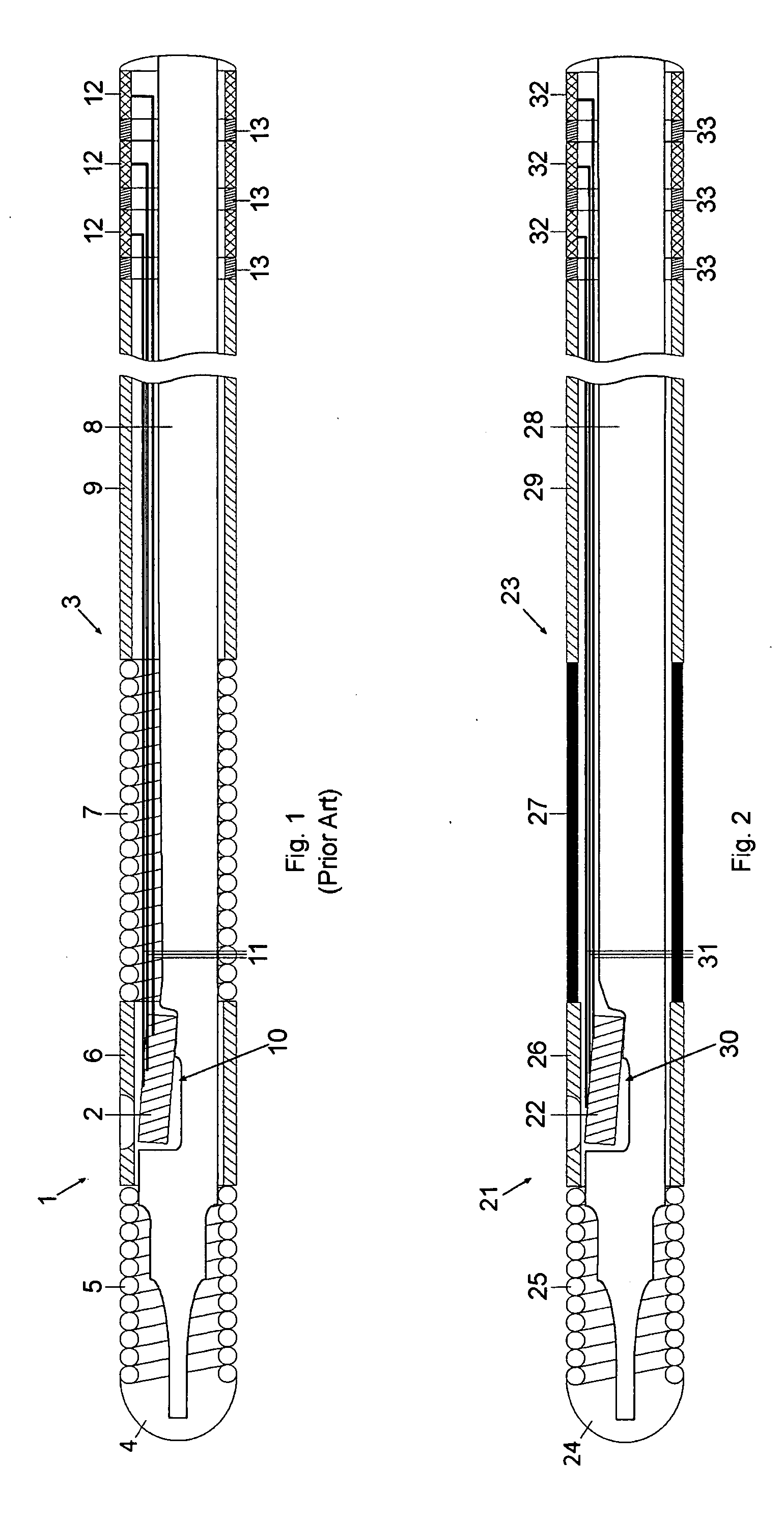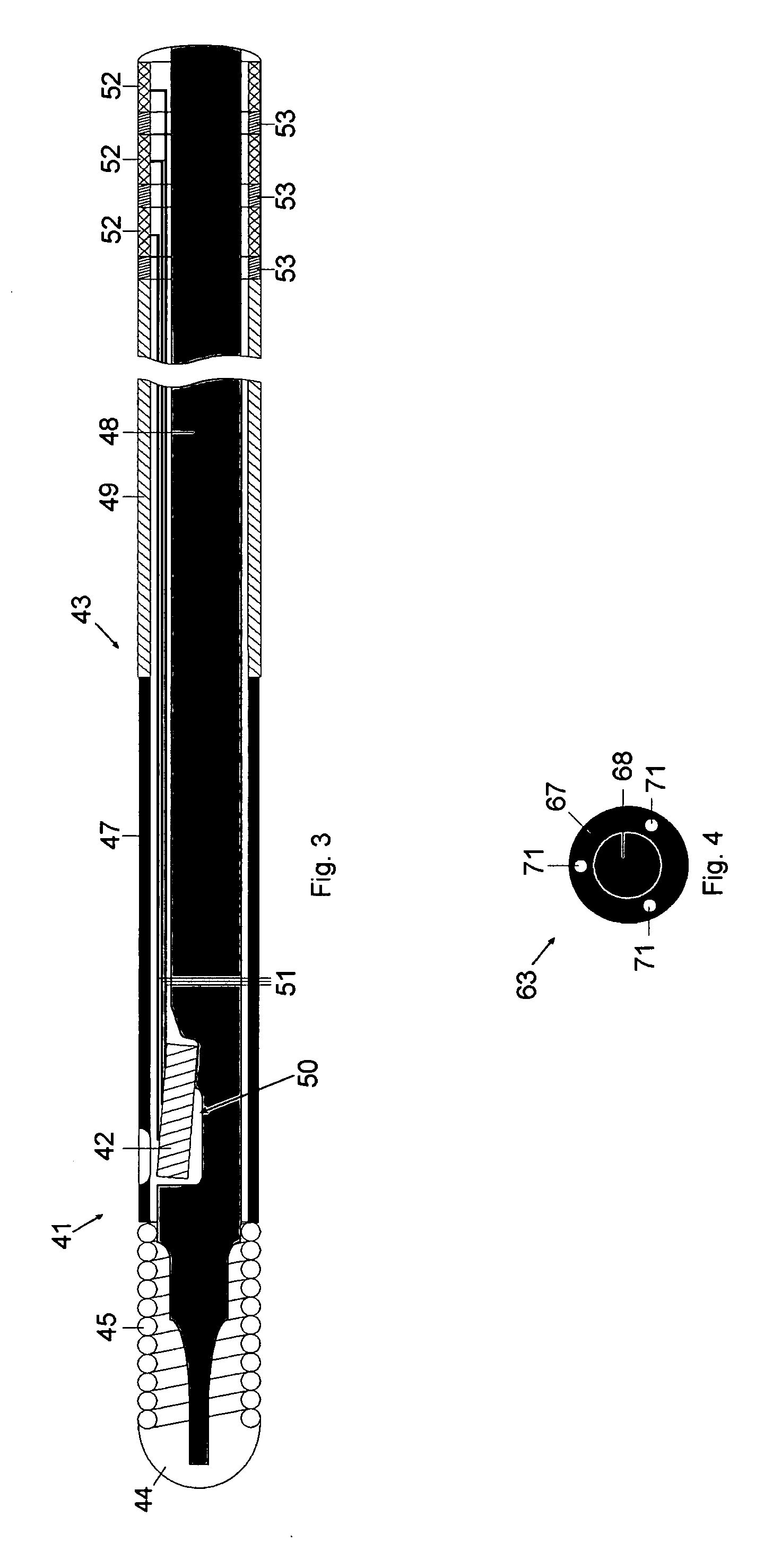Sensor and guide wire assembly
a technology of sensor guide wire and assembly, which is applied in the direction of guide wires, sensors, medical science, etc., can solve the problems of limited core wire diameter, jeopardizing compatibility, and inability to increase outer diameter, so as to improve the manoeuvrability of sensor guide wire and reduce the risk of electrical failure
- Summary
- Abstract
- Description
- Claims
- Application Information
AI Technical Summary
Benefits of technology
Problems solved by technology
Method used
Image
Examples
first embodiment
[0024] In FIG. 2 a sensor and guide wire assembly 21 according to the present invention is schematically illustrated. The sensor and guide wire assembly 21 comprises a sensor element 22, which is arranged in a distal portion of a sensor guide wire 23. More specifically, the sensor guide wire 23 comprises a distal tip 24, a distal coil spring 25, a jacket or sleeve 26, a core wire 28, and a proximal tube 29. The distal coil spring 25 is attached to the distal tip 24 and extends to the jacket 26, which serves as a housing for the sensor element 22. Unlike in a conventional design of a sensor guide wire, an example of which is shown in FIG. 1, the sensor guide wire 23 comprises further a polymer layer 27, which extends between the jacket 26 and the proximal tube 29. The distal coil spring 25, the jacket 26, the polymer layer 27 and the proximal tube 29 are all tubular members having essentially equal outer diameters and surrounding different consecutive portions of the core wire 28. Th...
second embodiment
[0028] In FIG. 3 a sensor and guide wire assembly 41 according to the present invention is schematically illustrated. The sensor and guide wire assembly 41 comprises a sensor element 42, which is arranged in a distal portion of a sensor guide wire 43. More specifically, the sensor guide wire 43 comprises a distal tip 44, a distal coil spring 45, a polymer layer 47, a core wire 48, and a proximal tube 49. The distal coil spring 45 is attached to the distal tip 44 and extends to the polymer layer 47. In this embodiment, the sensor element 42 is enclosed by the polymer layer 47, which also serves as a housing for the sensor element 42. The distal coil spring 45, the polymer layer 47 and the proximal tube 49 are all tubular members having essentially equal outer diameters and surrounding different consecutive portions of the core wire 48. The sensor element 42 is mounted in a recess 50 in a distal portion of the core wire 48, and is through a window in the polymer layer 47 in communicat...
fourth embodiment
[0030] a sensor and guide wire assembly according to the present invention comprises a sensor guide wire 63 having a cross-section which is schematically illustrated in FIG. 4. The sensor guide wire 63 comprises a core wire 68, three signal transmitting cables 71 and a polymer layer 67. Rather than being arranged around the signal transmitting cables 71—as in the previous embodiments—, the polymer layer 67 has been applied as a coating 67 on a section of the core wire 68, with the three signal cables 71 being embedded in the polymer coating 67. With this arrangement, the signal cables 71 can be produced without a separate insulating layer on each signal cable 71, because the polymer coating will electrically insulate each of the signal transmitting cables 71. When the signal cables are embedded in a polymer layer, the diameter of the core wire can be increased in comparison with an arrangement where a polymer layer in the form of a tubing surrounds the signal cables. The stiffness, ...
PUM
 Login to View More
Login to View More Abstract
Description
Claims
Application Information
 Login to View More
Login to View More - R&D
- Intellectual Property
- Life Sciences
- Materials
- Tech Scout
- Unparalleled Data Quality
- Higher Quality Content
- 60% Fewer Hallucinations
Browse by: Latest US Patents, China's latest patents, Technical Efficacy Thesaurus, Application Domain, Technology Topic, Popular Technical Reports.
© 2025 PatSnap. All rights reserved.Legal|Privacy policy|Modern Slavery Act Transparency Statement|Sitemap|About US| Contact US: help@patsnap.com



